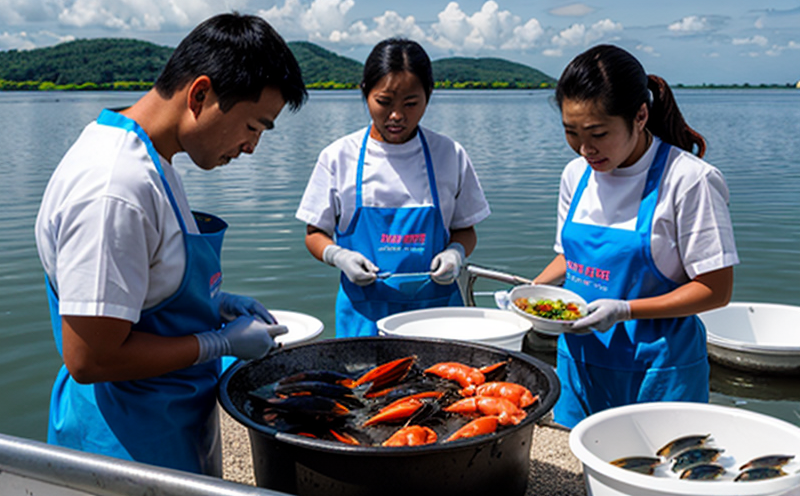ISO 8070 Chloride Content Determination in Fish
The determination of chloride content according to ISO 8070 is a critical aspect of ensuring food safety and quality, especially for seafood products. This standard provides precise methods for the analysis of total chlorides in fish, which are essential for monitoring the salinity levels and potential contamination from various sources.
Chloride ion (Cl-) plays a pivotal role in the chemical composition of seawater and is naturally present in marine organisms. However, excessive chloride content can indicate environmental stressors or contamination, such as industrial effluents or improper handling during processing. The ISO 8070 method ensures that seafood products meet international quality standards by accurately measuring chloride levels.
The testing process involves several key steps: sampling, preparation of the sample, and analysis using potentiometric titration. Sample preparation typically includes drying the fish to a constant weight, grinding it into a fine powder, and then digesting with hydrochloric acid or nitric acid. This step is crucial for ensuring that all chloride ions are liberated from their compounds.
The analytical procedure employs standard silver nitrate solution (AgNO3) titration against potassium thiocyanate (KSCN) indicator. The endpoint is detected by a change in color of the solution, indicating complete reaction between Ag+ and Cl-. This method is highly sensitive and reproducible, making it suitable for detecting even trace amounts of chloride ions.
The results are expressed as mg Cl-/kg fish sample. Compliance with this standard ensures that seafood products are safe for consumption and meet regulatory requirements. By adhering to ISO 8070, laboratories can provide reliable data that supports informed decision-making in the food industry.
Understanding the chloride content is also crucial from an environmental perspective. High levels of chloride ions in fish tissue may suggest exposure to contaminated water sources or improper storage conditions. This information aids in tracing the origin of contamination and implementing corrective measures to prevent further adulteration.
The importance of this method extends beyond just compliance; it contributes significantly to enhancing consumer confidence in seafood products. By ensuring that chloride levels fall within acceptable limits, laboratories play a vital role in maintaining food safety standards globally.
Eurolab Advantages
- State-of-the-Art Facilities: Our advanced laboratory infrastructure supports accurate and reliable testing of seafood samples according to ISO 8070. This includes specialized equipment for sample preparation, precise analytical instruments, and controlled environments.
- Expertise and Experience: Our team comprises highly skilled scientists with extensive experience in food safety analysis. They stay updated on the latest methodologies and standards, ensuring that our clients receive cutting-edge services.
- Comprehensive Reporting: We provide detailed reports that not only comply with ISO 8070 but also offer insights into potential sources of contamination or variability in chloride levels across different samples.
- Timely Delivery: Our efficient workflow management ensures rapid turnaround times without compromising on accuracy. This is particularly beneficial for businesses needing timely results for regulatory submissions or quality control purposes.
At Eurolab, we pride ourselves on delivering exceptional service that exceeds industry expectations. With our commitment to precision and excellence, you can trust us to provide accurate chloride content determinations in fish products.
Quality and Reliability Assurance
The accuracy of ISO 8070 chloride content determination relies heavily on rigorous quality control measures implemented throughout the testing process. At Eurolab, we adhere strictly to these protocols to ensure consistent and reliable results.
Firstly, our sample preparation procedures are meticulously followed to guarantee that all components contribute equally to the final analysis. This includes precise weighing of samples, thorough grinding, and careful digestion steps using appropriate reagents.
The analytical method itself demands meticulous attention to detail. The choice of silver nitrate solution concentration and endpoint detection criteria must be consistent across all tests. Regular calibration checks are performed on our equipment to maintain accuracy over time.
Data interpretation also plays a significant role in ensuring reliable results. Our analysts carefully review each set of data, cross-referencing it against established standards like ISO 8070. Any discrepancies or outliers are investigated further before final reports are generated.
By maintaining these stringent quality controls, Eurolab guarantees that every test conducted aligns with the highest international standards. This commitment to precision and reliability ensures that clients receive trustworthy results they can rely upon for decision-making processes.
Competitive Advantage and Market Impact
- Enhanced Reputation: Compliance with ISO 8070 enhances the reputation of seafood brands, making them more attractive to consumers who are increasingly concerned about food safety and quality.
- Informed Decision-Making: Accurate chloride content determination helps manufacturers make informed decisions regarding production processes, ingredient sourcing, and product formulation. This leads to improved product consistency and reduced risks associated with contamination.
- Regulatory Compliance: Meeting ISO 8070 standards ensures that seafood products meet legal requirements in various markets, opening up new opportunities for export and international trade.
- Customer Trust: Reliable testing builds trust among customers, fostering long-term relationships and enhancing brand loyalty. It also aids in maintaining market credibility during product launches or promotions.
In summary, adherence to ISO 8070 chloride content determination provides significant competitive advantages by ensuring high-quality products while meeting regulatory expectations. This approach not only protects consumers but also strengthens business operations through better resource allocation and risk management strategies.





